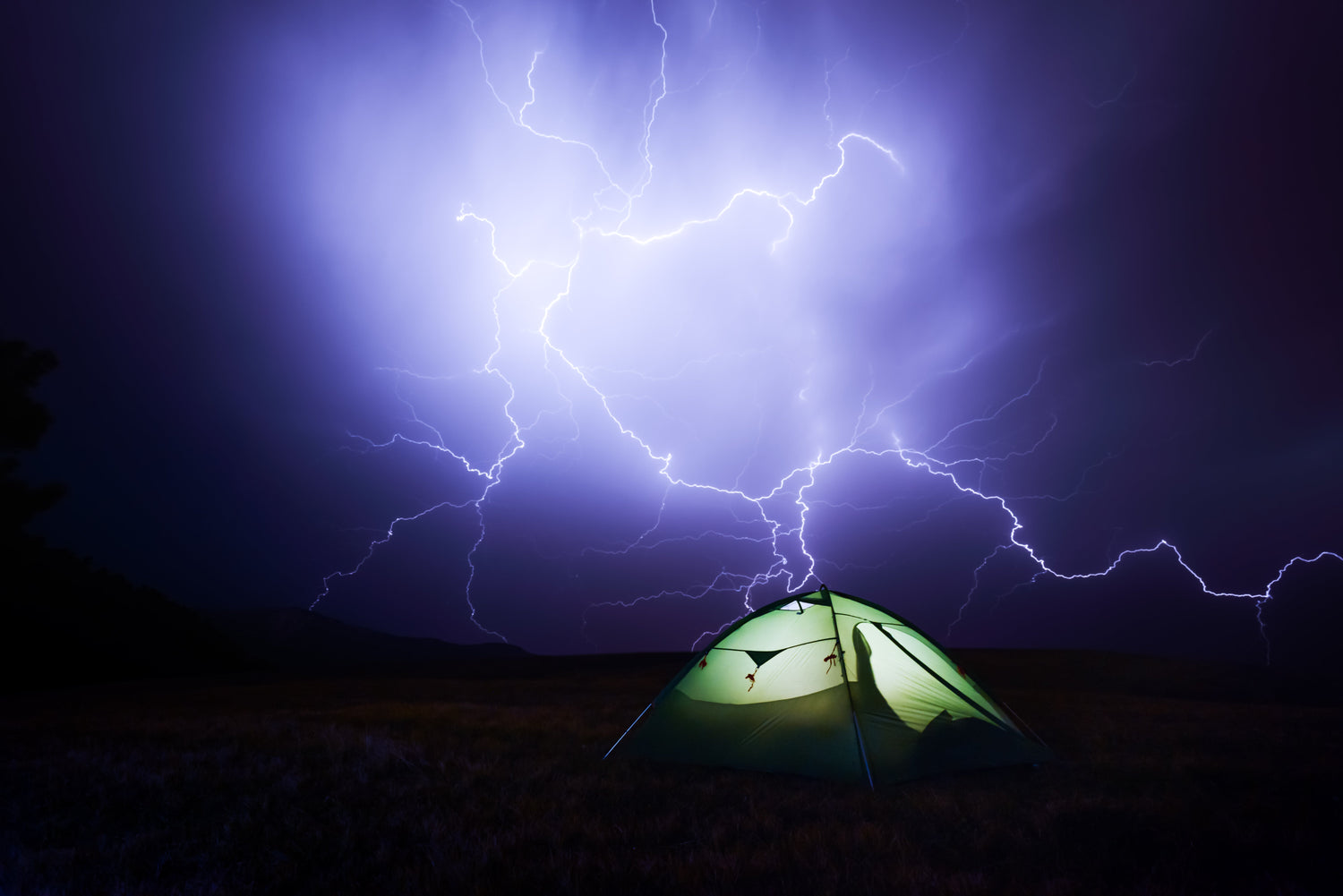Hello dear camping friends! Just imagine: You're sitting comfortably in front of your tent or camper, the barbecue smells nice, the birds are chirping... and then you see these dark clouds gathering on the horizon. The rumbling gets louder. Panic? No way! A summer thunderstorm is as much a part of camping as the starry sky. And with the right knowledge, you'll not only be safe, but can also approach this natural spectacle with respect and composure. Today, I'll show you how you and your loved ones can always stay on the safe side during thunderstorms and heavy rain - I promise!
By the end of this guide, you will know exactly how to prepare, where to find the best shelter and what to do after the storm. Whether you're traveling in a tent, caravan or motorhome, you'll find all the answers here.
Camping washbasin and water filter system I BOXIO WASH MAX +
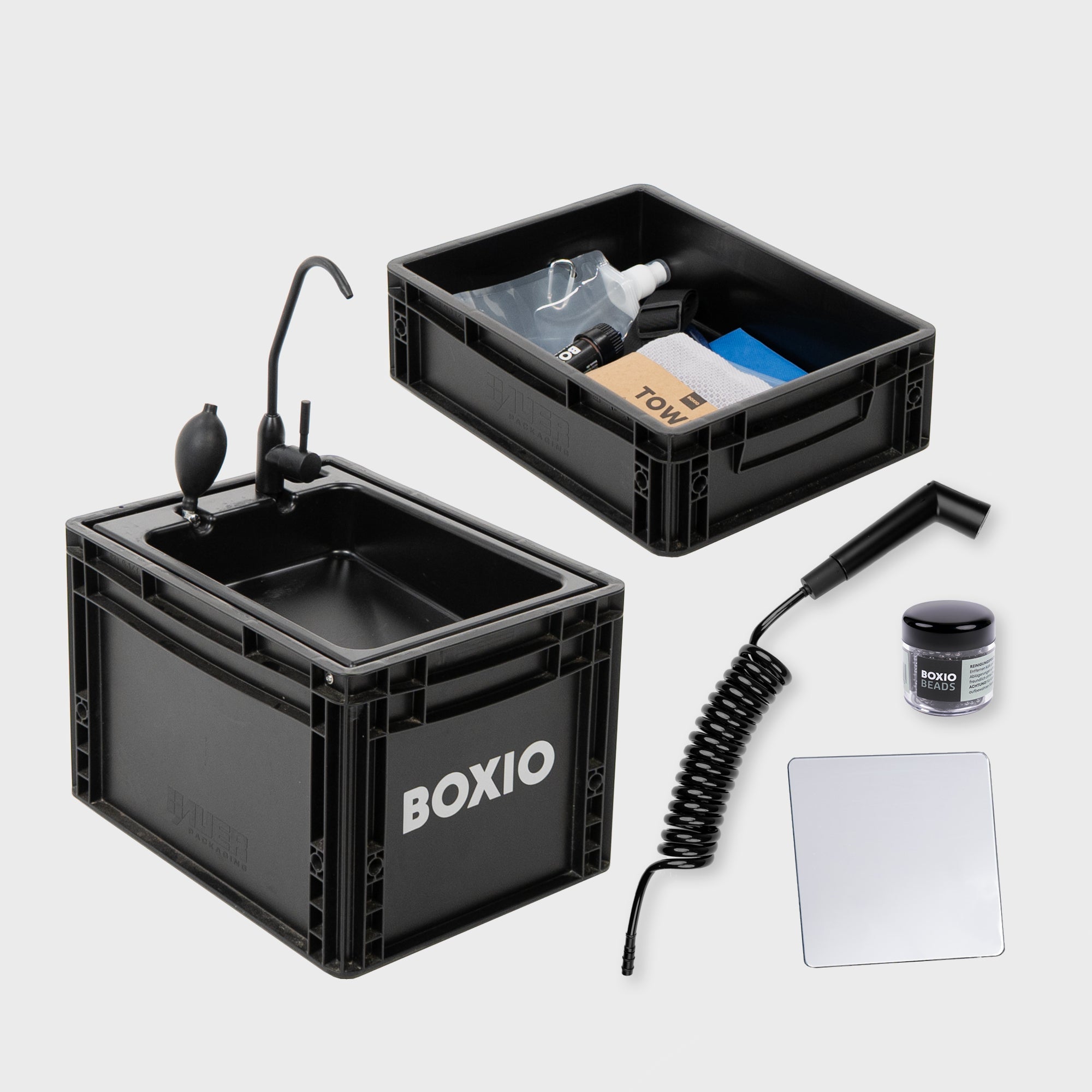
Good planning is half the battle - the right preparation for severe weather
The best way to get through a thunderstorm safely is to start preparing long before the first lightning strikes. If you take this section to heart, you won't even need many of the emergency tips later on. Safety doesn't start with the storm, it starts with planning.
Keep an eye on the weather - your digital watchdog
Thunderstorms are often heralded by muggy air, sudden cooling and towering clouds.1 But you shouldn't rely on your gut feeling alone. Modern technology is your best friend here. Make sure you download a reliable weather warning app before your trip. This will send official severe weather warnings from the German Weather Service (DWD) or other authorities directly to your cell phone.2
Set up the app so that you receive warnings for your current location and your home town. That way you are always informed. The most important apps for campers in Germany are the WarnWetter app from the DWD and the disaster warning app NINA from the Federal Office of Civil Protection and Disaster Assistance (BBK).4 They not only warn of thunderstorms, but also of heavy rain, storms and flooding.
|
App name |
Publisher / Focus |
Core functions |
Ideal for... |
|
WarnWetter |
German Weather Service (DWD) |
Detailed weather maps, rain radar, lightning detection, warnings at community level.6 |
Campers who appreciate precise weather patterns and detailed radar images. |
|
NINA |
Federal Office for Civil Protection (BBK) |
Official civil protection warnings, weather warnings from the DWD, flood information, other hazardous situations.4 |
Campers who prefer an all-in-one solution for all conceivable hazards from one official source. |
|
KATWARN |
Fraunhofer FOKUS / private providers |
Often regional warnings, sometimes integrated into other systems.5 |
Campers staying in regions where KATWARN is primarily used by local authorities. |
Choosing the right location - the be-all and end-all of your safety

Your location is crucial to your safety. A tent or camper does not become safer by placing it in a dangerous location. Learn to read the terrain and recognize the "no-go" zones.9
You should avoid these places at all costs when there is a risk of thunderstorms:
-
Exposed, elevated places: Hills, ridges, peaks or even just the highest point in an open meadow are off limits. Lightning strikes preferentially at the highest points.1
-
Single trees and forest edges: Stay away from single, tall trees, small groups of trees and the edge of the forest. Lightning can strike here and also jump over to your tent or vehicle.1 The same applies to masts, flagpoles or metal fences.13
-
Water and depressions: Never camp directly on the banks of a river, lake or stream. Dry riverbeds or deep hollows are also extremely dangerous. In heavy rain, they can turn into raging torrents in minutes.9 Water also conducts lightning currents over long distances.1
You are now faced with a bit of a dilemma: you should avoid high areas for lightning protection, but also avoid depressions due to the risk of flooding. So what should you do? The solution is the happy medium. Find a spot that is lower than the surrounding elevations, but is not itself the lowest point in the terrain. A slightly elevated spot within a sheltered depression can be ideal, as long as the water can drain away easily. The safest alternatives are the inside of a forest with many trees of about the same height or sheltered hollow paths.9 However, even in the forest, keep a safe distance of at least 10 meters from the trunks, as trees can fall or lose large branches in storms.1
Making your camp storm-proof - a checklist before the storm
When a warning comes in or the sky darkens, it's time to act. Go through this checklist to make your camp safe:
-
Secure your tent: Tighten all, really all, guy lines. Use the right pegs for the ground so that they hold even in windy and wet conditions.1
-
Awnings & awnings: Always retract awnings. They offer the wind a huge surface to attack and can cause serious damage.20 Awnings should also be secured with storm straps.18
-
Stow everything loose: Clear away chairs, tables, barbecue, toys and washing lines. Stow everything in the car or camper. Flying objects are a serious hazard during storms.1
-
Seal up: Close all windows, doors and skylights on your tent or camper to keep the wind and rain out.13
Mobile outdoor kitchen with standing height I BOXIO KITCHEN PLUS
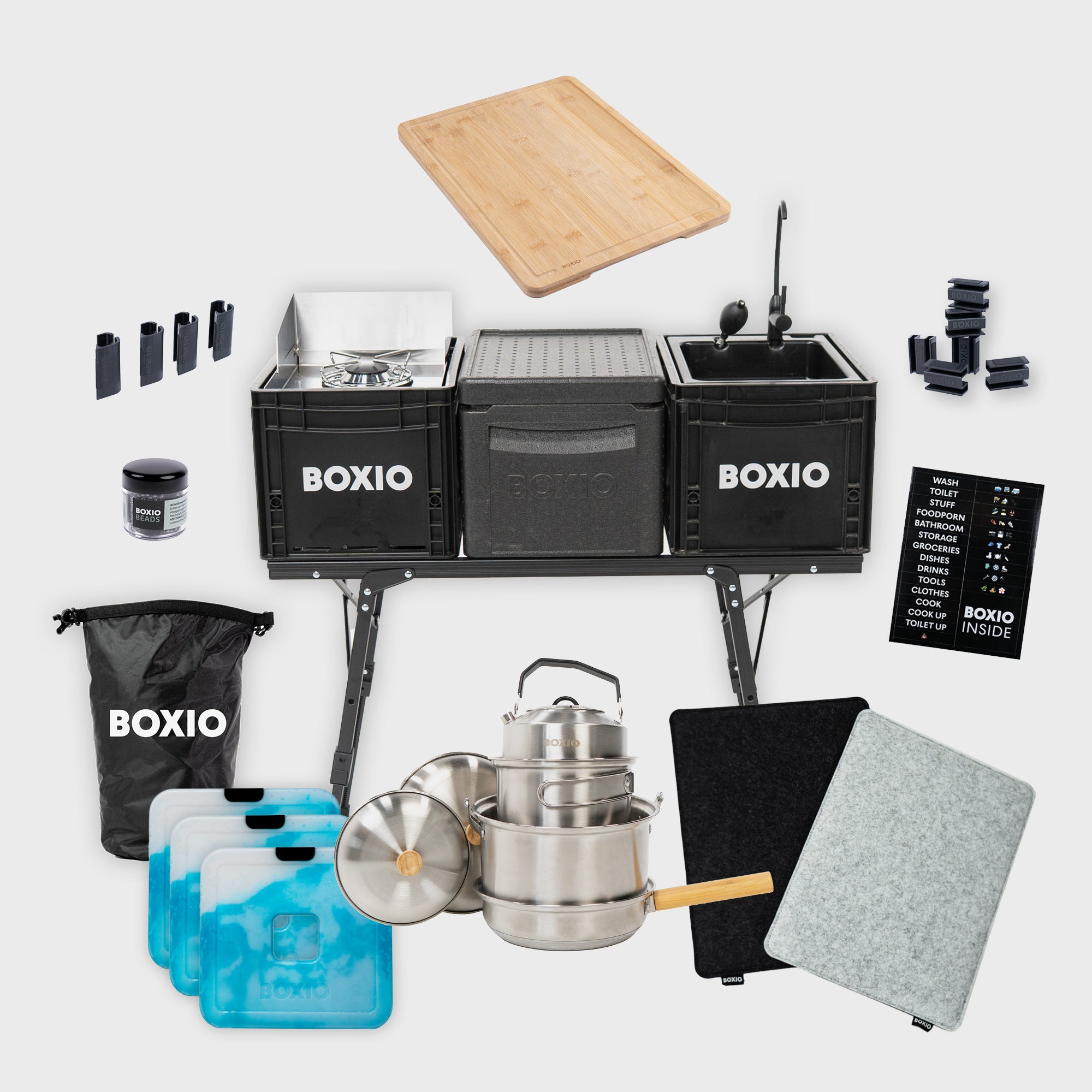
Protection in the fabric house? How to behave in your tent during thunderstorms
Let's make it short and clear: a normal camping tent offers no protection from a lightning strike.9 The metal poles can even attract lightning. The current then flows over the poles into the ground and can penetrate the tent floor and spread around.12 Your top priority must therefore always be to find a safer place.
The golden rule: get out of the tent!
As soon as a thunderstorm approaches, leave your tent. Count the seconds between lightning and thunder. If you divide this number by three, you will get the approximate distance of the thunderstorm in kilometers (d≈3tseconds km).3 If the thunderstorm is less than 10 km away (i.e. approx. 30 seconds between lightning and thunder), it is time to seek shelter.12
The safest places are:
-
Fixed buildings: the sanitary facilities, reception or a recreation room at the campsite are ideal as they usually have lightning protection.1
-
A car: A vehicle with a closed metal body is a very safe place (more on this in the next section).1
When there is no way out - The emergency protocol in the tent
Sometimes the storm comes too quickly and you can't get away in time. The following rules of conduct are not a safe option, but merely a measure to limit the damage. They only make staying in the tent less dangerous than other forms of behavior. The danger remains.
-
Go to the center of the tent: Crouch down in the middle of the tent, as far away from the poles and tent walls as possible.11
-
Assume the crouching position: Crouch down, place your feet very close together, pull your knees to your chest and hug your legs with your arms.1 This way, you provide the smallest possible area of attack for the current that spreads across the ground in the event of a close impact (known as "step voltage").9
-
Isolate yourself from the ground: Sit in this crouched position on a dry air mattress or camping bed. However, do not touch the ground or metal parts of the lounger.11
never lie flat on the ground or on a simple camping mat - this does not provide sufficient protection.9 -
No contact: Never touch the tent poles or tent walls under any circumstances.11 Also keep at least three meters away from other people in the tent.1
-
Cut the power: Remove all power cables (e.g. from a cool box) that lead into the tent from outside.13
Safe in the metal shelter - the correct behavior in motorhomes & caravans
A vehicle with a closed metal shell is an extremely safe place during a thunderstorm. The reason for this is a physical principle called a "Faraday cage". But beware: not every camper is automatically a safe cage.
The Faraday cage - your personal lightning rod on wheels
If lightning strikes a car or camper with a conductive outer shell made of metal (steel or aluminum at least 0.5 mm thick), the current flows along the outside and is discharged into the ground via the tires or supports.14 The interior remains free of dangerous electric fields - you are protected.11
Is my camper safe? The crucial material check
Whether your vehicle offers this protection depends solely on its construction. The differences are vital.
-
Safe vehicles: Panel vans, camper vans and many semi-integrated motorhomes have a continuous metal body and act as a safe Faraday cage.12 The metal driver's cabin is a safe retreat in every type of motorhome.11
-
Unsafe vehicles: Many caravans and motorhome bodies are made of insulating plastic (GRP) without a continuous, conductive metal frame. These vehicles offer NO protection against lightning strikes! 12 Lightning would seek the shortest route to earth here - and this could be through gas pipes, the electrics or, in the worst case, through the occupants.12
-
Risk zones: Pop-up roofs or lifting roofs made of plastic tear a gap in the protective cage. Close them during thunderstorms and stay away from this area - above all, do not bring your head near the roof.11 The same applies to alcoves, which are often made of plastic.11
This table will help you to quickly categorize your vehicle:
|
Vehicle type |
Safety level (lightning protection) |
Most important rule of conduct |
|
Panel van / camper van (metal) |
High |
Stay in the vehicle, follow the rules. |
|
Partial/integrated motorhome (metal body) |
High |
Stay in the vehicle, avoid alcoves. Safest place: Driver's cab.12 |
|
Motorhome / caravan (GRP body) |
Very low / No protection |
Leave the vehicle! Seek shelter in a solid building or a car.12 If this is not possible: Crouch on the floor in the middle of the vehicle.13 |
|
Caravan (metal body) |
Medium to high |
Stay in the vehicle, follow the rules. |
|
Any vehicle with a plastic pop-up roof |
Reduced |
Close the pop-up roof! Keep your head away from the roof area. Prefer to stay in the driver's cab.13 |
The golden rules in a safe camper
If you are in a vehicle with a functioning Faraday cage, follow these rules to be absolutely safe:
-
Close everything: Windows, doors and roof hatches must be completely closed.13
-
Cut shore power: Unplug the 230V cable on the outside of the vehicle. Place the plug at least one meter away. This prevents overvoltage damage to your electronics.12
-
Retract antennas: Retract satellite dishes and other antennas.12
-
Avoid water: Don't shower, wash dishes or touch metal faucets.12
-
Avoid metal: Do not touch any metal parts of the interior that may be connected to the body.9
-
Stay inside: Never get in or out of the car during a thunderstorm. Touching the vehicle and the ground at the same time could create a bridge for the electricity and the dangerous step voltage could injure you.13
Camping cooking set I BOXIO COOK Max +
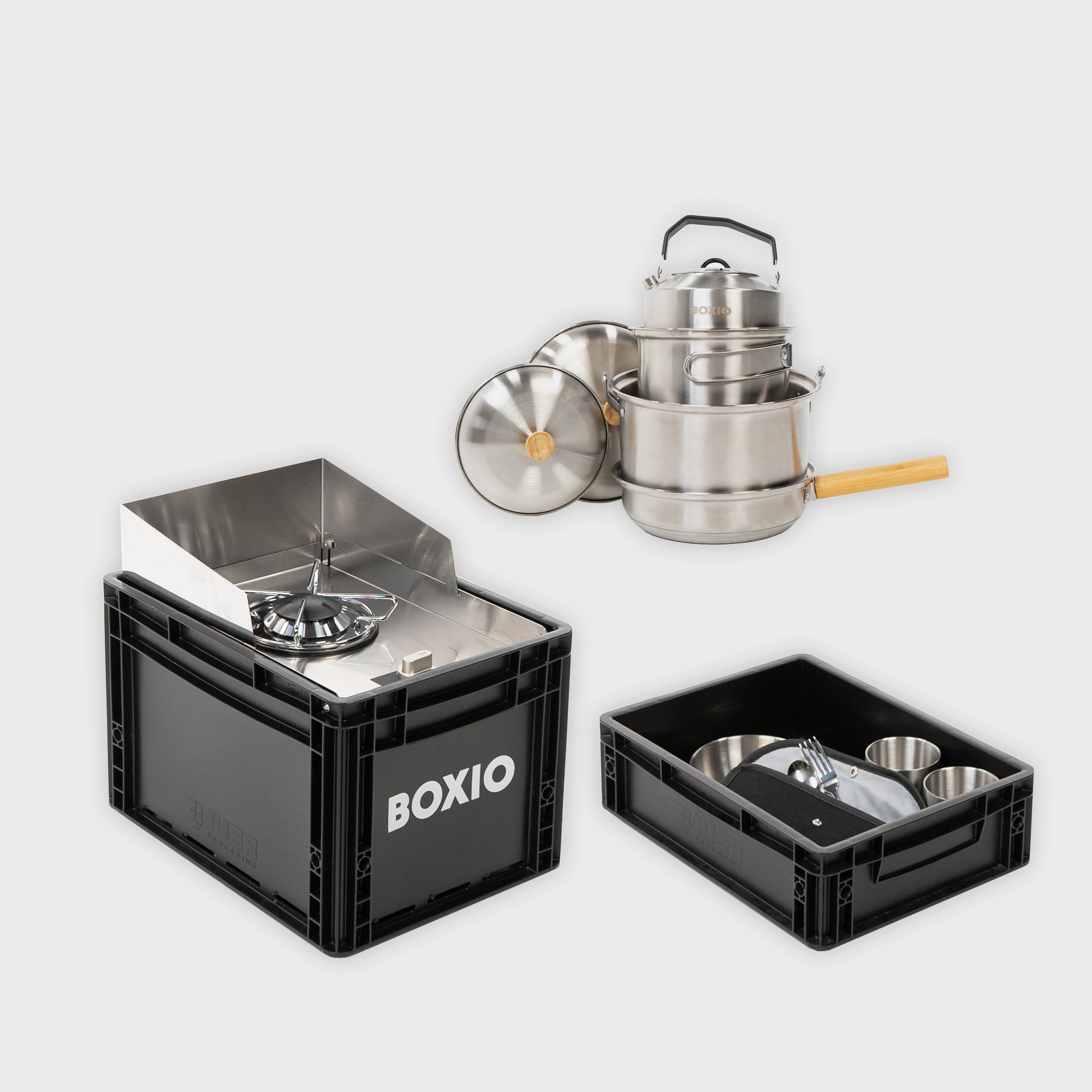
When the sky cries - dealing with heavy rain and the risk of flooding
A thunderstorm rarely just brings lightning. Heavy rain is an equally great danger that is often underestimated. It's not just about getting wet, but the real threat of flooding and torrents.
Keeping the tent dry - tips against the deluge from above and below
A wet tent is more than just uncomfortable. These tricks will keep your camp a dry oasis:
-
Protection from below: Place an additional groundsheet under your tent. However, make sure that this groundsheet does not protrude from under the flysheet at any point. Otherwise it will act like a tub, collecting rainwater and channeling it directly under your tent floor.16
-
Protection from above: A tightly tensioned tent is the be-all and end-all. Only then can the water run off cleanly and no heavy water pockets form on the roof, which could damage the poles.16 Make sure that the inner tent does not touch the wet outer tent anywhere, otherwise the moisture will push through.16
-
Protection from the inside (condensation): The biggest problem in modern tents is often not rain, but condensation. In the warm, damp interior of the tent, the humidity condenses on the cold outer skin. The solution: ventilate, ventilate, ventilate! Keep the ventilation openings open even when it's raining so that air can circulate.16
-
Organization is everything: Store wet jackets, shoes and rucksacks in the awning or under a tarp, but never in the sleeping area. This also prevents condensation from forming.16 Important electronics, clothing and documents belong in waterproof pack sacks.16
When the stream becomes a raging torrent - the danger of floods
This is one of the deadliest dangers when camping. You have found an idyllic spot by a small, babbling brook. The weather app warns of heavy rain, but the stream looks harmless. There is a psychological trap lurking here: we tend to trust the visible reality more than an abstract warning. However, the danger is not the current water level, but the amount of water that may come from the mountains or fields in the next few minutes.15 The flood disasters of recent years, such as in the Ahr valley in 2021, have shown that campsites near rivers are extremely vulnerable and have to be evacuated within a very short time.32
Don't believe your eyes, but the weather app and the instructions of the authorities or campsite staff. A stream that is now ankle-deep can wash away your car in an hour.
-
Follow instructions: If an evacuation is ordered, don't argue. Act immediately and calmly.20
-
Don't drive through water: Never try to cross flooded roads or meadows. You cannot see what is under the surface of the water and the current can carry your vehicle away.20
BOXIO SANITARY | Mobile bathroom
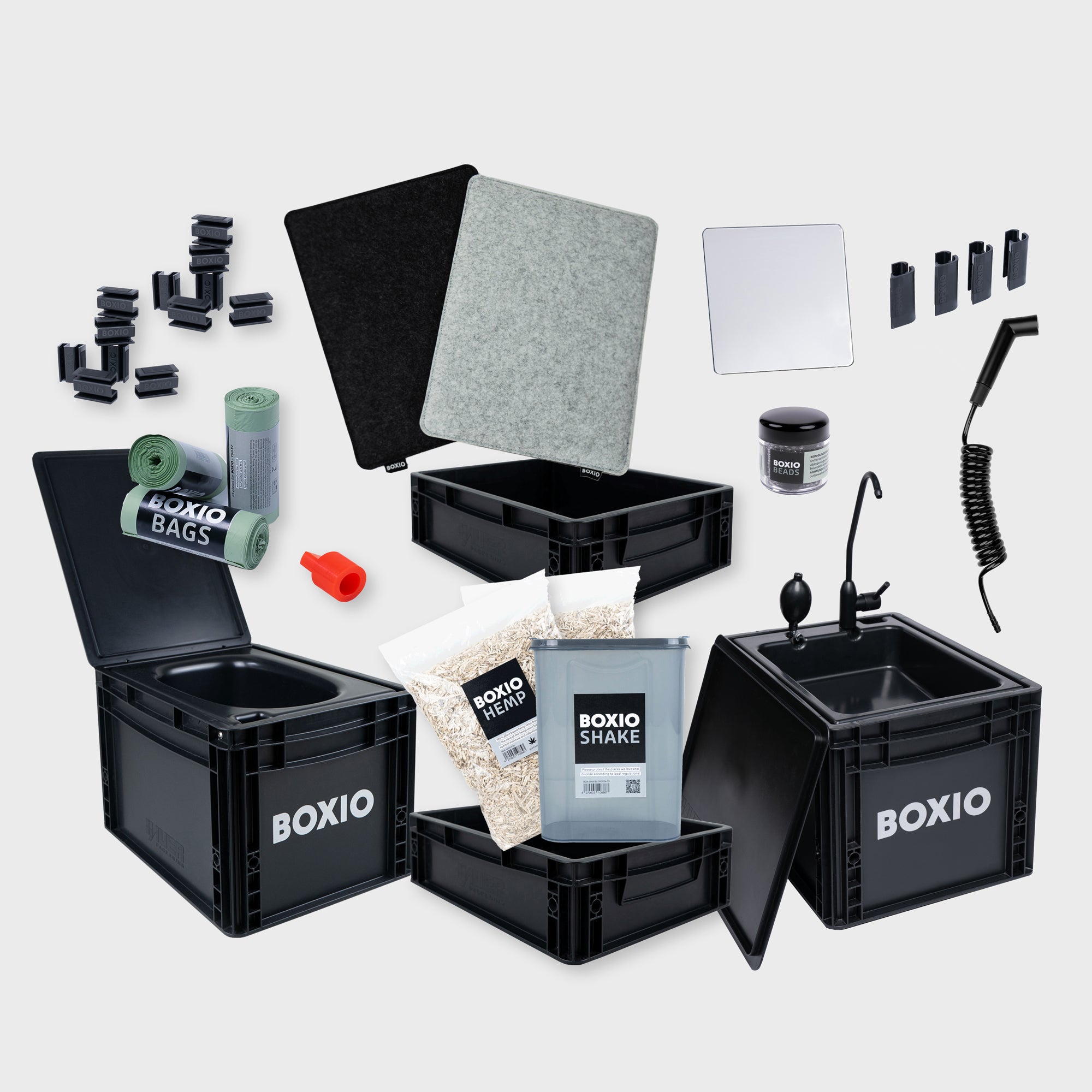
After the storm is before the next adventure - cleaning up, checking and helping
The rumbling has died down, the sun is peeking through the clouds again. Now it's time for a cool head, a thorough check and maybe even some neighborly help.
All-clear! But when is it really over?
The danger is only over when you hear nature calm down again. The universal safety rule is: only when you havenot heard any morethunder for 30 minutes is the thunderstorm considered to be over. Only then is it safe to leave your shelter and start clearing up.1
The big check - what has the storm done?
Take time to systematically inspect your camp and the surrounding area:
-
The surroundings: Look up! Are there loose branches hanging in the trees above your pitch? Are there signs of instability on the slope? Keep your distance from fallen trees.15
-
Your tent: Check the tarpaulin for tears, the poles for breaks or deformations and the seams for leaks. Check sleeping bags and equipment for wetness.15
-
Your camper: If you suspect that lightning may have struck (e.g. by a loud bang or smell of burning), check the tires carefully for small holes or cracks. Lightning can damage the steel belt inside.12 Test the on-board electronics and check the gas lines for leaks before putting them back into operation.13
First aid in the event of a lightning accident - acting correctly when every second counts
Even if it rarely happens, you should know what to do. First things first: A person struck by lightning is not electrified. You can touch and help them immediately and safely.23
-
Safety: Get yourself and the victim out of the immediate danger zone (e.g. away from a peak).11
-
Emergency call: Alert the emergency services immediately by calling 112.2
-
Immediate life-saving measures: Check consciousness and breathing. If no pulse or breathing can be detected, start cardiopulmonary resuscitation immediately.
-
Care: Keep the victim warm, preferably with a rescue blanket, and reassure them if they are conscious.11 Cool visible burns (entry and exit wounds) with water.11
The emergency kit - what you should always have with you
A well-stocked first-aid kit is worth its weight in gold when camping. You should add a few things to it for bad weather:
-
Standard first aid kit: With bandages, plasters (including blister plasters), disinfectant spray, scissors and tweezers.36
-
Medication: Painkillers, anti-diarrhea medication and personal medication.31
-
Emergency equipment: A rescue blanket (protects against hypothermia), a headlamp, a multitool and waterproof matches or a lighter.31
-
Repair: Seam sealant and special adhesive tape for quick repairs to tents or equipment.29
Your next camping adventure can begin!
Now you're well prepared! A thunderstorm while camping doesn't have to be a cause for concern. It is an impressive natural spectacle that you can safely survive with the necessary respect and the right preparation.
The most important points are simple: prepare well, know your location and your vehicle, and act calmly and without hesitation in the event of a warning.
Save this guide, share it with your camping friends and enjoy your next tour - in sun, wind and yes, even rain. Because with the right knowledge, there is no such thing as bad weather, only the next adventure. Stay safe and see you at the campsite soon!


